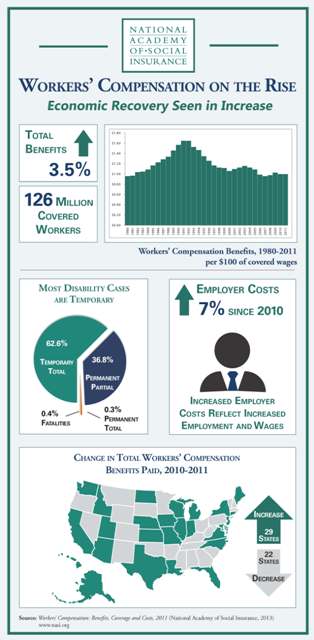For Immediate Release | August 20, 2013
WASHINGTON, D.C. – After declining in the wake of the recession, workers’ compensation benefits paid to injured workers and costs borne by employers increased in 2011 as the U.S. economy continued to recover, according to a new report by the National Academy of Social Insurance (NASI).
Total benefits rose by 3.5 percent to $60.2 billion. The benefits include a 4.5 percent rise in medical care spending to $29.9 billion and a 2.6 percent rise in wage replacement benefits to $30.3 billion. Total costs to employers rose by 7.1 percent to $77.1 billion.
"Workers’ compensation often grows with the growth in employment and earnings,” said Marjorie Baldwin, chair of NASI’s Workers’ Compensation Data Panel and Professor of Economics in the W.P. Carey School of Business at Arizona State University. When benefits and costs are measured relative to total covered wages, then benefits remained unchanged, and costs to employers rose very modestly (to $1.27 per $100 of wages) after declining in the previous five years.
|
Workers’ Compensation Benefits, Coverage, and Costs, 2011
|
||
|
Aggregate Amounts
|
2011
|
Percent Change
|
|
Covered workers (in thousands)
|
125,833
|
1.1%
|
|
Covered wages (in billions)
|
$6,049
|
3.9%
|
|
Workers' compensation benefits (in billions)
|
$60.2
|
3.5%
|
|
Medical benefits
|
$29.9
|
4.5%
|
| Cash benefits | $30.3 | 2.6% |
| Employer costs (in billions) | $77.1 | 7.1% |
|
Amounts per $100 of covered wages
|
2011
|
Dollar Change
|
|
Benefits paid
|
$1.00
|
$0.00
|
|
Medical benefits
|
$0.49
|
$0.00
|
|
Cash payments to workers
|
$0.50
|
-$0.01
|
|
Employers' costs
|
$1.27
|
$0.03
|
|
Source: National Academy of Social Insurance estimates.
|
||
The new report shows changes in coverage, benefits, and employer costs for all 50 states and the District of Columbia. State-level changes in 2011 include:
- Coverage and wages increased in all 50 states and the District of Columbia.
- Total benefits paid to injured workers increased in 29 jurisdictions. However, benefits as a percent of total wages increased in only 17.
- Employers’ costs of workers’ compensation as a percent of total wages increased in 31 states, and remained unchanged in four.
- The share of benefits paid for medical care exceeded 50 percent in 33 states.
Workers’ compensation was the first social insurance program in the United States; 2011 marked the 100th anniversary of the first state laws. NASI’s report, Workers’ Compensation: Benefits, Coverage, and Costs, 2011, is the 16th in an annual series. “The NASI report is an essential tool for experts in the field,” said Eric Nordman, member of NASI’s data panel and Director of Research at the National Association of Insurance Commissioners. The report provides the only comprehensive data on workers’ compensation benefits, coverage and employer costs for the nation, the states, the District of Columbia and federal programs.
For a copy of the printed report, media can contact Jill Braunstein at (202) 452-8097, ext. 1303 or by e-mail at jbraunstein@nasi.org. All others should contact Ishita Sengupta at isengupta@nasi.org.
EXPERTS TO CONTACT:
Ishita Sengupta, National Academy of Social Insurance
(202) 452-8097 | isengupta@nasi.org
Marjorie Baldwin (research), Arizona State University
(480) 577-2771 | Marjorie.baldwin@asu.edu
Virginia Reno, National Academy of Social Insurance
(202) 452-8097 | vreno@nasi.org
Eric Nordman (insurance regulator) National Association of Insurance Commissioners
(816) 783-8005 | enordman@naic.org
The National Academy of Social Insurance is a non-profit, nonpartisan organization made up of the nation’s leading experts on social insurance. Its mission is to advance solutions to challenges facing the nation by increasing public understanding of how social insurance contributes to economic security.
See related news: Disability, Workers' Compensation

